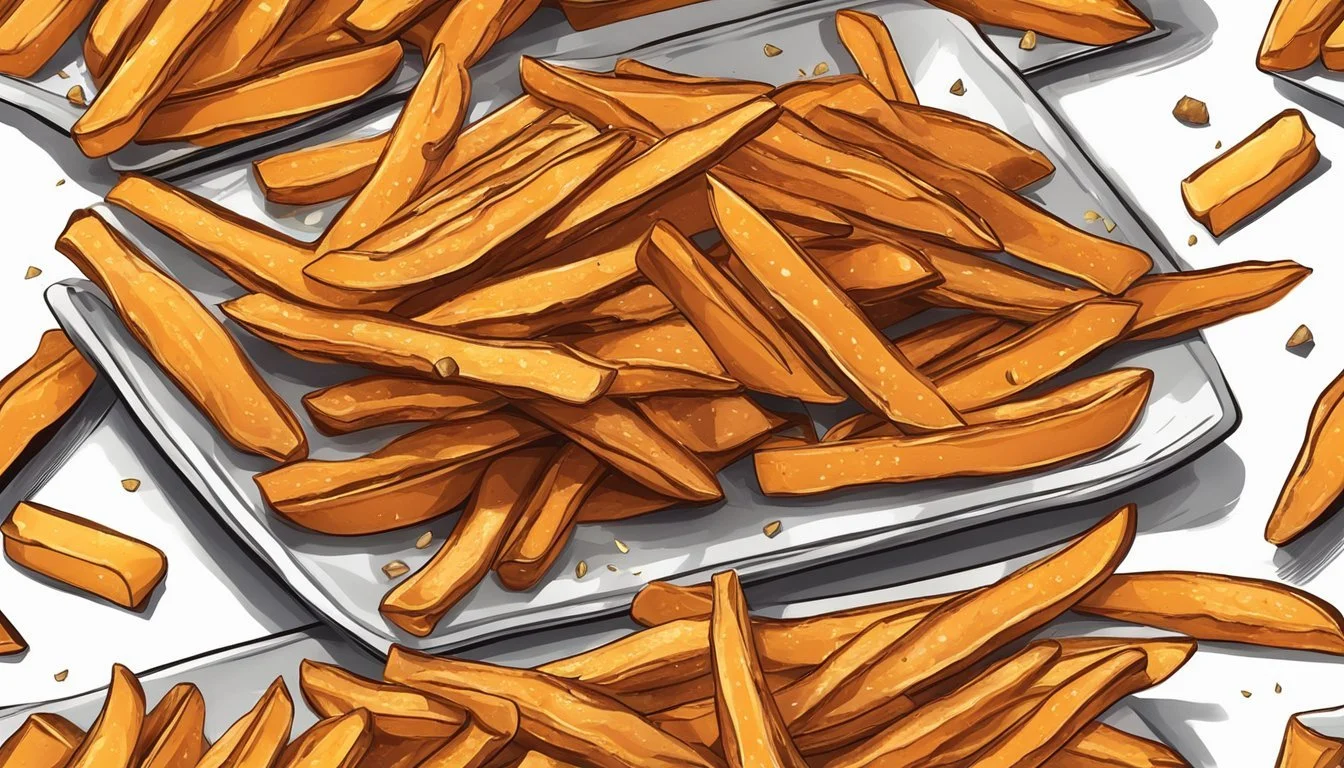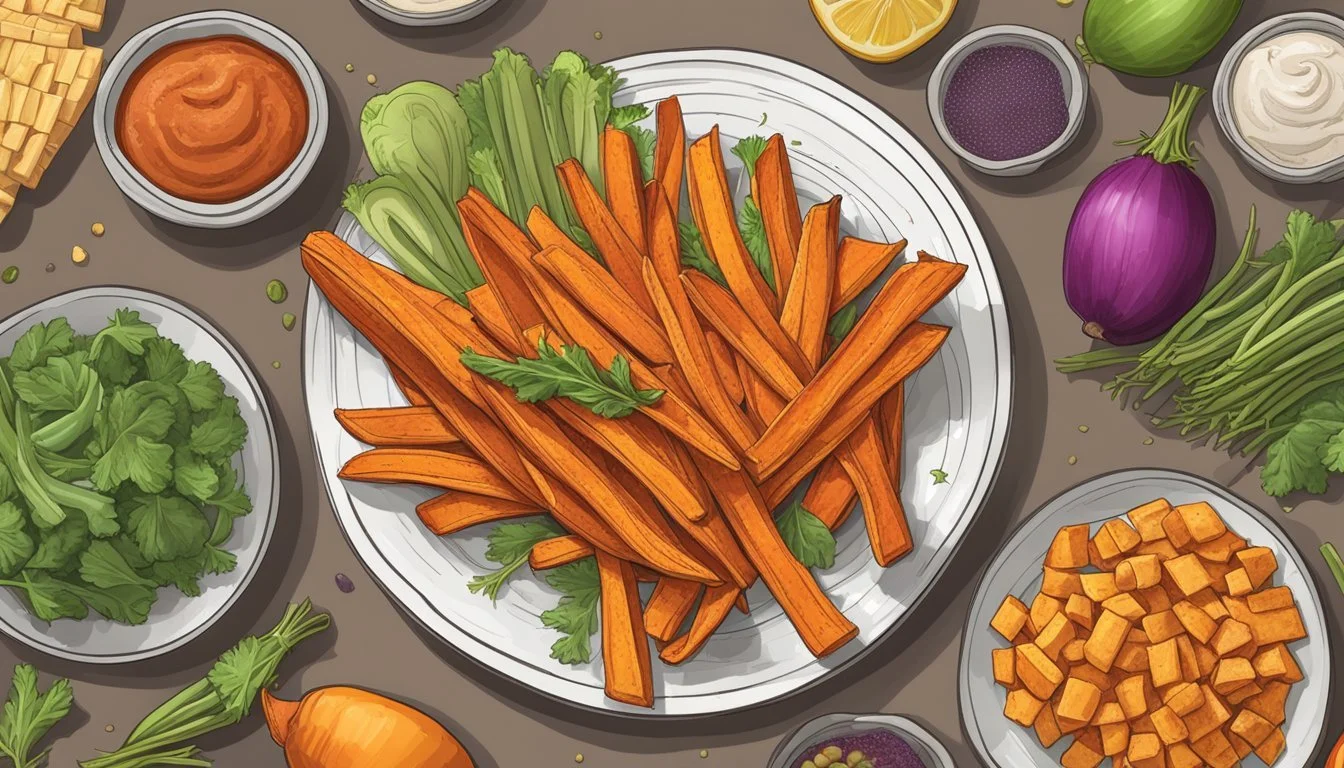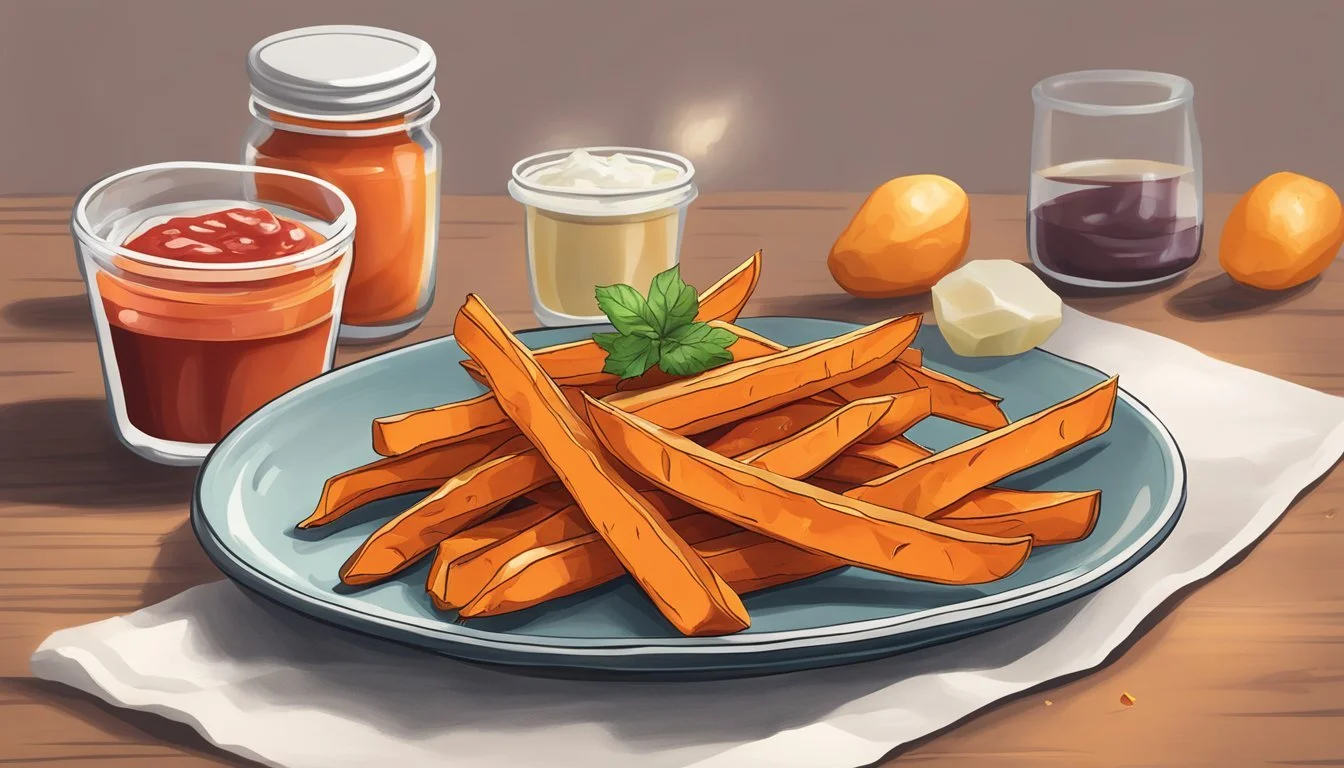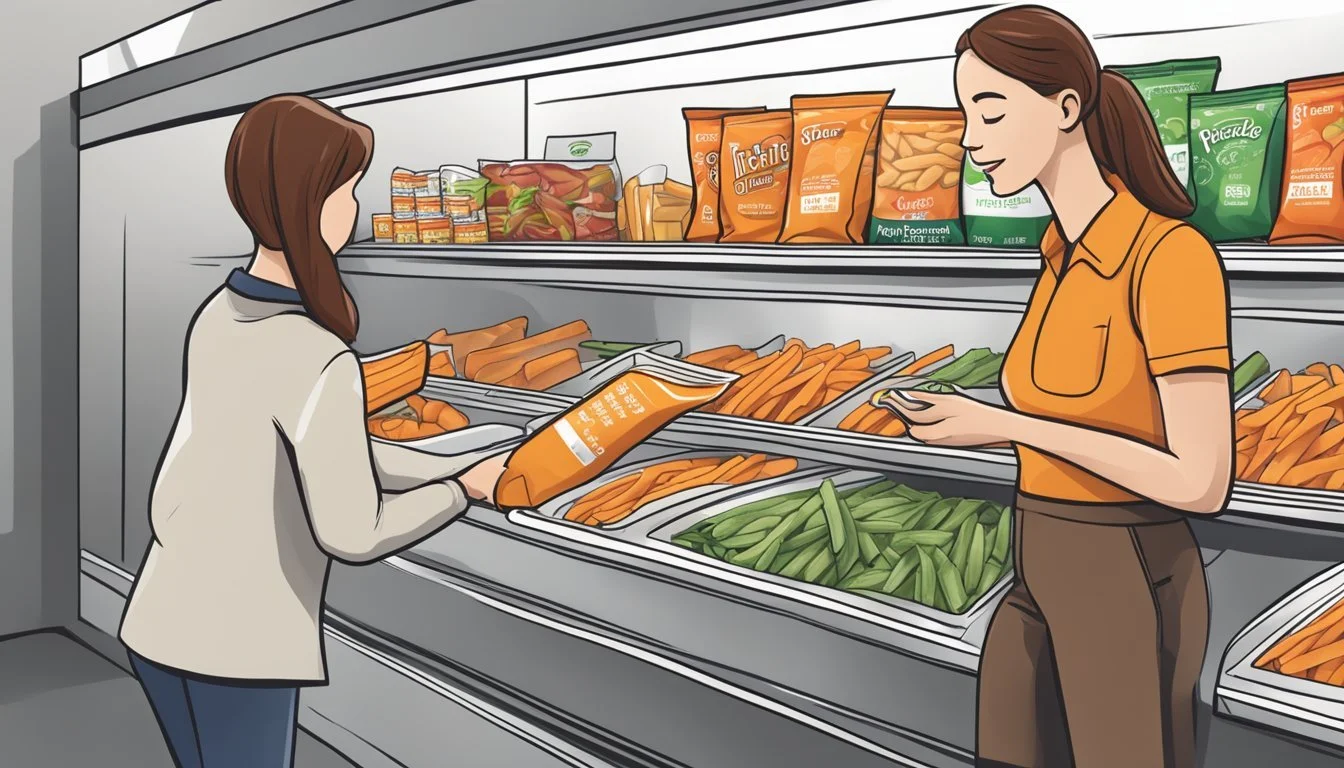Are Sweet Potato Fries Gluten-Free?
Uncovering the Truth About This Popular Snack
Sweet potato fries are a popular food choice for those aiming to indulge in comfort food while adhering to dietary restrictions, such as a gluten-free diet. Gluten is a group of proteins found in wheat, barley, and rye, and it can cause health problems for individuals with celiac disease or gluten intolerance. Fortunately, sweet potatoes (What wine goes well with potatoes?) in their natural form do not contain gluten, making them a safe option for those on a gluten-free diet.
However, when it comes to prepared sweet potato fries, the gluten content can vary. Those made at home typically lack gluten as long as they're prepared with gluten-free seasonings and cooking techniques. On the other hand, commercially prepared sweet potato fries may not always be gluten-free. Flour is sometimes added to packaged fries to enhance their crispiness, but this flour often contains gluten. For individuals with celiac disease, even a small amount of gluten can lead to intestinal damage, making it crucial to verify the gluten content in store-bought products.
It's essential for consumers to scrutinize labels and inquire about preparation methods when purchasing or ordering sweet potato fries, ensuring they align with a gluten-free diet. Cross-contamination with gluten-containing foods during processing, cooking, or serving is also a possible risk that must be considered. Therefore, vigilance is paramount to maintain a strict gluten-free diet and avoid adverse reactions.
Sweet Potato Fries Basics
This section explores what sweet potato fries are and their nutritional value, with a focus on their relevance in gluten-free diets.
What Are Sweet Potato Fries?
Sweet potato fries are a popular alternative to traditional French fries made from white potatoes. They are created by cutting sweet potatoes (What wine goes well with sweet potatoes?), which are a root vegetable, into thin, stick-like shapes and cooking them until crisp. Sweet potato fries can be prepared in various ways, including baking or frying. They are often praised for their natural sweetness and robust nutritional profile, offering a flavorful option that fits within a gluten-free diet.
Nutritional Profile of Sweet Potato Fries
Sweet potatoes are highly nutritious, providing an array of essential vitamins and minerals. Here is a brief overview of their nutritional content:
Fiber: Sweet potatoes are a good source of dietary fiber, which aids in digestion and offers a feeling of fullness.
Protein: While not a protein powerhouse, sweet potato fries contain a modest amount of this macronutrient.
Vitamins and Minerals: They are rich in vitamins such as Vitamin A (from beta-carotene), Vitamin C, and several B vitamins. Minerals include potassium and manganese.
In terms of their nutrient spectrum, sweet potato fries deliver more than just energy; they supply critical nutrients that support overall health. Whether baked or fried, they can be a nutritious component of any meal—especially for those requiring gluten-free options.
Gluten-Free Considerations
When considering whether sweet potato fries are gluten-free, it is important to understand the nature of gluten, how it affects those with celiac disease, and the potential of cross-contamination during preparation and cooking.
Understanding Gluten
Gluten is a group of proteins found primarily in wheat, barley, and rye. It acts as a binding agent, providing elasticity and moisture retention in foods. While gluten is harmless for most individuals, it can cause health issues for those with gluten sensitivities or celiac disease. Celiac disease is an autoimmune disorder where the ingestion of gluten leads to damage in the small intestine.
The basic premise of a gluten-free diet is the exclusion of all foods containing wheat, barley, rye, and derivatives of these grains. Oats are naturally gluten-free, but they are often processed in facilities that handle gluten-containing grains, which raises the potential for cross-contamination. It's essential to ensure that oats are labeled gluten-free, meaning they are processed in a gluten-free environment.
Gluten-Free Diet and Celiac Disease
People with celiac disease must adhere to a strict gluten-free diet, as consuming gluten will trigger an autoimmune response that can cause intestinal damage and other serious health issues. Adhering to this diet allows individuals with celiac disease to lead healthy lives. Research continually advances the understanding of gluten-related disorders, leading to better diagnostic methods and awareness of gluten-free dietary needs.
Cross-Contamination Risks
Cross-contamination is a critical concern for individuals requiring gluten-free foods. It occurs when gluten-free products come into contact with gluten through shared utensils, fryers, or preparation surfaces. With sweet potato fries, the risk lies in whether they are prepared and cooked in a shared facility or with equipment that also processes gluten-containing foods.
At home: If making sweet potato fries from scratch, ensure all surfaces and utensils have been thoroughly cleaned and separate them from those used for gluten-containing foods.
Eating out or purchasing prepared fries: One should verify if the fries are made in a dedicated gluten-free fryer and if the establishment is knowledgeable about gluten-free practices.
By considering the nature of gluten, dietary requirements for celiac disease sufferers, and awareness of cross-contamination, consumers can make informed decisions about gluten-free products like sweet potato fries.
Preparation and Cooking
When preparing sweet potato fries, selecting quality ingredients and employing proper techniques ensures a gluten-free and delicious outcome. Factors such as the type of sweet potato, whether to peel the skin, and how to cut them significantly influence both the prep time and the quality of the final baked product.
Selecting the Right Sweet Potatoes
For fries, one should choose firm sweet potatoes with smooth, unblemished skin. The presence of soft spots may indicate spoilage, which can affect taste and texture. Varieties such as Beauregard and Garnet are known for their sweet, moist flesh, which caramelizes well when baked.
To Peel or Not to Peel
Peeling sweet potatoes is a matter of personal preference and nutritional consideration. The skin adds fiber and nutrients but may have a different texture than the flesh. One can either leave the skin on for added health benefits or peel it off for a more uniform fry.
Cutting Techniques for Sweet Potato Fries
Cutting sweet potatoes into even sticks is crucial for consistent baking. One can start by cutting the sweet potatoes into 1/4" thick slabs, then slicing these into fries of similar width. Uniformity in size ensures even cooking.
Cutting Steps:
Slice off the ends of the sweet potato.
Cut into 1/4" slabs.
Slice slabs into 1/4" fries.
Before baking, tossing the fries with a light coating of oil — options include avocado, olive, or sunflower oil — can enhance crispiness. Bake the prepared fries in a preheated oven at a high temperature, typically around 400°F, arranging them in a single layer on a baking sheet to ensure they cook evenly.
Sweet Potato Fries Recipes
Sweet Potato Fries are inherently gluten-free and make for a deliciously healthy alternative to traditional fries. They can be prepared in various ways with an assortment of seasonings and methods to cater to a wide range of tastes.
Classic Baked Sweet Potato Fries
For classic baked sweet potato fries, one begins by preheating the oven to 425°F. A baking sheet is lined with parchment paper for easy release of the fries after baking. Sweet potatoes are thoroughly washed, dried, and cut into 1/4-inch thick sticks. In a large bowl, combine the fries with a drizzle of oil—such as avocado oil—and a generous sprinkle of salt. Arrange the seasoned sweet potato sticks in a single layer on the baking sheet without them touching each other to ensure they become crispy. Bake in the preheated oven until they are golden brown and crisp, flipping once halfway through the cooking process.
Seasonings and Spices Variations
Variety comes from the spices and seasonings used to flavor the sweet potato fries. Here's a simple seasoning mix to consider:
1 tsp of garlic powder
1 tsp of paprika
1/2 tsp of black pepper
1/4 tsp of chili powder
One can mix these spices in a bowl and toss the cut sweet potatoes in the mixture before baking. Experimenting with different combinations can lead to finding the perfect custom blend. Additional spices, such as cumin or onion powder, can also be used according to taste. For extra crispy fries, one might lightly dust the oil-tossed sweet potatoes with a bit of cornstarch before adding the spices.
Alternative Cooking Methods
Aside from baking, sweet potato fries can also be roasted or even grilled. To roast, one can cook the fries at a higher temperature of 450 degrees, potentially achieving a crispier texture. When grilling, fries should be placed in a single layer on top of a piece of foil coated with oil to prevent sticking and then grilled over medium heat. Regardless of the method, it's crucial to flip the fries partway through the cooking for even crispness. Additionally, some prefer to soak the cut sweet potatoes in cold water for 10 minutes before drying and seasoning them, which can help achieve a crispier outcome when baked.
Health and Dietary Considerations
Sweet potato fries can be a nutritious addition to various diets, including gluten-free, provided they are prepared mindfully. It’s important to consider how they fit into one’s overall nutritional needs and dietary restrictions.
Sweet Potato Fries in a Gluten-Free Diet
Sweet potatoes are naturally gluten-free, making them a suitable choice for individuals with celiac disease or those following a gluten-free diet. However, cross-contamination is a risk if the fries are prepared in a facility that also processes wheat. For those with celiac disease or high gluten sensitivity, it's crucial to ensure that sweet potato fries are labeled "Gluten-Free," indicating they meet strict standards to avoid cross-contamination.
Caloric and Nutritional Balance
While sweet potatoes provide valuable nutrients including potassium, fiber, and a range of vitamins, deep frying can add significant calories. For a healthier alternative, baked sweet potato fries offer fewer calories and can fit into a range of diets such as vegan, dairy-free, and paleo.
Nutrition Aspect Baked Sweet Potato Fries (per 1/2 cup) Calories 86 Carbs 20g Fat 0.05g Protein 1.6g Fiber 3g
Dietary Adaptations for Allergies
In addition to being gluten-free, sweet potato fries can be adapted to avoid common allergens like soy, corn, and dairy. Individuals should opt for coatings and seasonings that do not contain these allergens. Baking sweet potato fries with olive or avocado oil and using healthy seasonings such as sea salt and garlic powder can make them suitable for a variety of dietary needs.
Storage and Reheating Tips
Proper storage and reheating are essential to maintain the quality of sweet potato fries. Heeding these tips ensures leftover fries stay as fresh and crispy as possible.
Storing Leftover Sweet Potato Fries
To store leftover sweet potato fries, it's best to keep them in an airtight container in the refrigerator. They can last for 3-4 days when stored this way. For those opting to keep fries for a longer duration, storing them in the freezer is an option. Initially freeze the fries spread out on a baking sheet to prevent sticking, then transfer them to a freezer-safe container or bag.
Fridge: Store in an airtight container.
Freezer: Freeze on baking sheet, then transfer to a container or bag.
Reheating for Best Texture
When it comes to reheating, the goal is to restore the fries' original crispness. The oven or air fryer are preferable methods. Preheat the oven to 425°F (220°C), place fries on a preheated baking tray, lightly oil, and reheat for 5-10 minutes. Alternatively, use an air fryer set to 400°F (200°C) for 3-4 minutes. If the sweet potato fries are frozen, extend the heating time to 7-10 minutes in the air fryer.
Oven: Preheat to 425°F, reheat for 5-10 minutes.
Air Fryer: Preheat to 400°F, reheat for 3-4 minutes (7-10 minutes if frozen).
Serving and Accompaniments
When serving sweet potato fries, the right sauces, seasonings, and dish pairings can elevate them from a simple snack to a memorable culinary experience. Here are specific ways to serve and accompany this popular dish.
Dipping Sauces and Pairings
Sweet potato fries are often enjoyed with a variety of dipping sauces. Here are some popular options:
Classic ketchup remains a favorite for its balance of sweet and tangy flavors.
Spicy mayonnaise, enhanced with a blend of hot sauce or cayenne pepper, complements the sweet potato's natural sweetness.
Herb-infused aiolis offer a creamy texture with a burst of garlic and fine herbs.
Aside from sauces, one can sprinkle sweet potato fries with an array of seasonings:
Smoked paprika or garlic powder are common choices for a savory kick.
Cinnamon or nutmeg can be mixed with a hint of sugar for those who prefer a sweet-spiced version.
Pairing beverages include:
Craft beers, which can harmonize well with the savory and spicy notes.
Iced teas, as they provide a refreshing contrast to the richness of the fries.
Sweet Potato Fries as a Side Dish
Sweet potato fries often accompany main courses in both restaurants and homemade American meals. Here is how they can be served:
As a side dish to burgers and sandwiches, they offer a gluten-free alternative to traditional fries.
In a restaurant setting, chefs may serve them alongside grilled meats or fish, adding an upscale twist to the dish.
For a fusion of flavors, one can pair them with non-traditional entrees like tacos or wraps.
When preparing sweet potato fries at home, it is possible to incorporate butter or olive oil before baking for added richness and flavor. Choosing the right accompaniment can transform sweet potato fries from a mere side dish to a standout part of the meal.
Buying and Storing Sweet Potato Fries
When purchasing sweet potato fries, consumers should seek out clearly labeled gluten-free options and be aware of the correct storage methods to maintain freshness.
Selecting Pre-Made Sweet Potato Fries
When shopping for pre-made sweet potato fries, be vigilant in reading labels. Gluten-free sweet potato fries should be clearly marked as such to ensure they have not been contaminated with gluten during processing. For individuals with gluten sensitivities, selecting fries that are labeled certifiably gluten-free is crucial due to the potential for cross-contamination in facilities that also process wheat products.
Looking for single-layer frozen sweet potato fries can be beneficial. This indicates that the fries have been frozen in a way that prevents them from sticking together, suggesting a higher quality product that will cook more evenly when roasted or fried.
Optimal Storage Conditions for Freshness
For those who opt for homemade sweet potato fries from the root vegetable, proper storage extends the shelf-life and freshness. Before cooking, store sweet potatoes in a cool, dark place to keep them fresh. Once they are cut and ready to be made into fries, here's how to best store them:
Before Cooking:
Cut sweet potatoes can be kept in water in the refrigerator for a few hours to prevent browning if they are not to be cooked immediately.
After Cooking:
Leftover cooked sweet potato fries should be cooled to room temperature, placed in an airtight container, and stored in the refrigerator.
To ensure they maintain crispness, reheat the fries in a single layer on parchment paper in the oven.
Innovations and Trends
The sweet potato fry trend has surged with burgeoning consumer demand for healthier alternatives to traditional french fries. Innovations focus on adding unique flavors and textures, while dining establishments incorporate sweet potato fries into their menus to satisfy diverse dietary requirements.
Homemade Sweet Potato Fries Variations
Individuals crafting homemade sweet potato fries are experimenting with a variety of seasoning blends and cooking methods to create irresistible variations. The incorporation of herbs, spices, and alternative flours to promote crispness without gluten is common. Here are some innovative ways they're enhancing their homemade fries:
Seasonings: Smoked paprika, garlic powder, and cinnamon for a sweet-and-spicy kick.
Batters: Chickpea flour or rice flour as a gluten-free option to achieve crispiness.
Cooking methods: Air frying for a healthier approach that maintains the desired crunch.
Restaurant and Fast Food Options
Restaurants and fast food chains have recognized the popularity of sweet potato fries. They cater to the gluten-free community by including specifically labeled gluten-free options. Noteworthy trends in the dining sector include:
Designated fryers: To prevent cross-contamination with gluten-containing products.
Transparent menu labeling: Clearly identifying which sweet potato fry options are gluten-free.
Additionally, some establishments might offer sweet potato fries seasoned with exclusive spice blends, differentiating their products and attracting customers seeking unique flavor profiles.
FAQs About Sweet Potato Fries
This section addresses frequently asked questions about sweet potato fries, clarifying common misconceptions and providing advice for achieving the ideal fry.
Common Questions and Misconceptions
Are sweet potato fries gluten-free? Sweet potatoes are naturally gluten-free. This extends to homemade sweet potato fries, assuming they're not coated in flour or fried along with gluten-containing products. However, commercially prepared or frozen sweet potato fries may include gluten-containing ingredients for added crunch or flavor. Therefore, those with celiac disease or gluten sensitivity should verify the ingredients list on packaging or inquire at restaurants.
Can other types of potatoes be used to make gluten-free fries? Certainly. Varieties like red potatoes, russet potatoes, and purple potatoes are all naturally gluten-free and can be made into fries. Similar to sweet potatoes, the end product would only contain gluten if additional gluten-containing ingredients were added during preparation.
Is there a nutritional difference between sweet potato fries and baked sweet potatoes? Yes, sweet potato fries and baked sweet potatoes differ in preparation and consequently in fat content. Baked sweet potatoes retain more of their natural nutrients and have less fat since they're typically not cooked with oil, unlike fries.
Tips for Making the Perfect Sweet Potato Fries
Choosing the Right Oil: For homemade sweet potato fries, olive oil and avocado oil are popular choices due to their health benefits and high smoke points, which make them suitable for high-temperature cooking. Avocado oil, especially, has a neutral taste and can withstand temperatures necessary for crispy fries.
Seasoning for Flavor: To enhance the flavor profile, seasoning sweet potato fries with onion powder and cumin can provide a sweet and smoky taste. Both spices complement the natural sweetness of the potatoes and do not contain gluten, making them suitable for celiacs.
Cooking Technique: When making sweet potato fries, cut them into uniform pieces to ensure even cooking. Baking them at a high temperature, such as 400ºF (about 204ºC), can yield a crispy exterior with a tender interior. Using parchment paper or aluminum foil on the baking sheet prevents sticking and ensures easier cleanup. Moreover, spreading the fries in a single layer with space in between prevents them from steaming and helps achieve crispness.
Remember, for creating variations like baked potatoes, mashed sweet potatoes, or sweet potato chips, the principles of using gluten-free ingredients and proper cooking methods remain the same to accommodate those with dietary restrictions.










